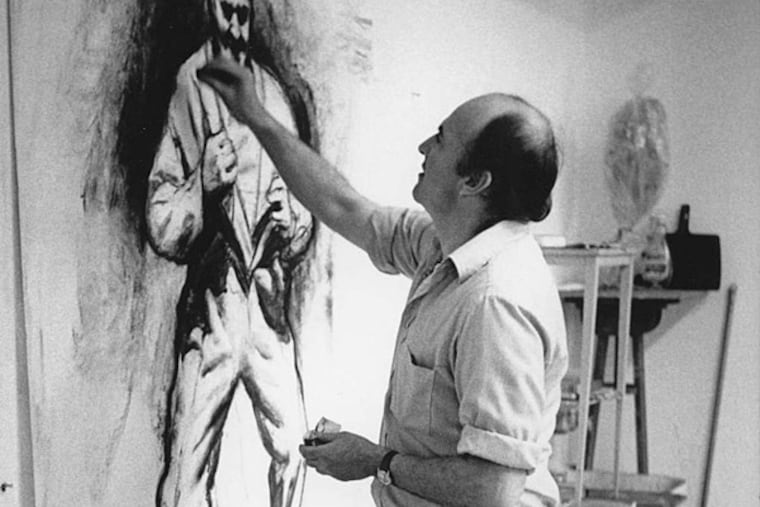Sidney Goodman, 77, acclaimed Philadelphia artist
Sidney Goodman, 77, one of the most acclaimed, influential, and respected artists Philadelphia has produced since the end of World War II, died Thursday, April 11. He suffered for the better part of a year from Parkinson's disease.

Sidney Goodman, 77, one of the most acclaimed, influential, and respected artists Philadelphia has produced since the end of World War II, died Thursday, April 11. He suffered for the better part of a year from Parkinson's disease.
A Philadelphia native, Mr. Goodman graduated from Philadelphia College of Art, now University of the Arts, in 1958. By the early 1960s, his boldly imaginative style of figurative painting had brought him national attention.
When he was 27, Time magazine described him as "one of the most respected and sought-after of the new figure painters." By 30, he had appeared in an important exhibition of figure painting at the Museum of Modern Art and in two Whitney Museum annuals.
Yet this son of Russian Jewish immigrants was sufficiently levelheaded to realize that such fame might be fleeting.
"I was new on the scene," he recalled during an interview in the mid-1990s. "Sometimes, I was almost a little embarrassed by the recognition because I knew that, today it might be me, but tomorrow it was going to be somebody else."
He hit the big time during a period of sharp transition from abstract expressionism, which dominated the late 1940s and '50s; pop art, which glorified mundane objects, was just one of the creative currents that young artists were riding.
Some critics touted Mr. Goodman as one of the leaders of a "new realism," but they were a bit off the mark. He was committed to portraying the human figure, but he wasn't a describer or a storyteller.
His paintings and drawings mixed observation with memory and imagination to produce images of powerful and sometimes disturbing emotional resonance. He could be intimate one minute, apocalyptic the next.
Mr. Goodman's art is existential and often Manichaean in spirit. It examines basic themes such as the human condition and elemental forces of nature. In his late pictures in particular, the images often are ambiguous, which makes it hard to assign definitive meanings.
He had a knack for investing perfectly ordinary scenes or objects - a mirror reflection of him shaving, for instance - with exceptional visual and metaphoric force.
On the occasion of a major Goodman exhibition at the Philadelphia Museum of Art in 1996, the late director Anne d'Harnoncourt recognized this when she remarked that "Sidney seems to all of us to be one of the very strongest figurative painters working in the United States today. I think he's a remarkable artist."
Mr. Goodman's early brush with national celebrity didn't tempt him to move to New York, which Philadelphia artists have always seen as art's Emerald City.
He had shown his work there throughout his career, first at Terry Dintenfass Gallery and later at ACA Galleries. But he always found Philadelphia a more congenial place to live, for an artist who wasn't a millionaire.
Over the decades, his work ended up in many prestigious collections, including those of the Metropolitan Museum of Art, the Museum of Modern Art, the Whitney Museum, the Art Institute of Chicago, the Philadelphia Art Museum, and the Pennsylvania Academy of the Fine Arts.
His resumé of collections and exhibitions is impressive both in breadth and depth. But in an Inquirer interview in 1996, he said that shows and reviews always were secondary to what was happening daily in his studio.
"If the painting is going well, that's the main thing. If it's not going well, then all the other stuff isn't going to help. I felt that way back in the '60s, and I feel that way today."
Anyone who saw his 1996 Art Museum exhibition, an extensive show of his drawings at the Pennsylvania Academy in 2009, or any of his local gallery shows in recent years might applaud the wisdom of that attitude.
(In 1980, the art museum at Pennsylvania State University organized a midcareer retrospective that traveled to the Delaware Art Museum in Wilmington.)
Mr. Goodman began teaching at the Pennsylvania Academy in 1978; he retired in 2011. Before that, he had taught for 18 years at Philadelphia College of Art. Between the two schools, he helped to shape the careers of several generations of art students.
He described teaching as "a rewarding experience. At PAFA, there is an atmosphere where I can practice what I preach."
According to Jeffrey Carr, dean of the academy school, what Mr. Goodman preached had a strong undertone of art history that is also visible in his painting.
"This makes his work equally of this moment and profoundly informed by the past," Carr said.
Over the course of his career, Mr. Goodman received a number of formal honors, including a Guggenheim Foundation fellowship in 1962, the Hazlette Memorial Award for Excellence in the Arts (Painting) in 1986, and an honorary doctorate from Lyme Academy College of Art in 2006.
He is survived by his wife of 35 years, the artist Pamela McCabe; two daughters, Maia and Amanda; a son, Lucas; and a sister, Norma Mayron.
A memorial service will be at 1 p.m. Sunday, April 14, at Goldsteins' Rosenberg's Raphael-Sachs funeral home, 6410 N. Broad St.